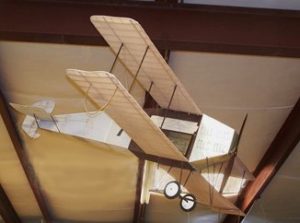 This model replicates on a small scale the actual airplane which was a two-seat biplane designed by A.V. Roe to participate in the 1912 British Military Aeroplane Competition. It was unique in that it had a fully enclosed crew compartment. The fuselage occupied the entire gap between the upper and lower wings.
At the trials for the contest, the Type G placed first in the assembly test and fuel consumption tests, but its poor rate of climb prevented it from winning the major prize. It was the second British airplane to recover from a spin and the first to do so in front of witnesses. In August of 1912, Lt. Wilfred Parke, with Lt. Breton as a passenger, took off to make an endurance trial. After having flown for three hours, he was executing a series of dives and while turning entered a spin at about 700 feet. By a combination of luck and cool nerves coupled with flying skill, he was able to recover when he was barely 50 feet above the ground. This was a most significant event as going into a spin had previously meant almost certain death.
Crew: One pilot, One passenger Wingspan: 35 feet 3 inches
Length: 28 feet 6 inches Empty Weight:1,191 lbs
Loaded Weight: 1,792 lbs Powerplant:Green D.4 inline 60hp
Maximum speed: 62 mph
Source: en.wikipedia.org
This model replicates on a small scale the actual airplane which was a two-seat biplane designed by A.V. Roe to participate in the 1912 British Military Aeroplane Competition. It was unique in that it had a fully enclosed crew compartment. The fuselage occupied the entire gap between the upper and lower wings.
At the trials for the contest, the Type G placed first in the assembly test and fuel consumption tests, but its poor rate of climb prevented it from winning the major prize. It was the second British airplane to recover from a spin and the first to do so in front of witnesses. In August of 1912, Lt. Wilfred Parke, with Lt. Breton as a passenger, took off to make an endurance trial. After having flown for three hours, he was executing a series of dives and while turning entered a spin at about 700 feet. By a combination of luck and cool nerves coupled with flying skill, he was able to recover when he was barely 50 feet above the ground. This was a most significant event as going into a spin had previously meant almost certain death.
Crew: One pilot, One passenger Wingspan: 35 feet 3 inches
Length: 28 feet 6 inches Empty Weight:1,191 lbs
Loaded Weight: 1,792 lbs Powerplant:Green D.4 inline 60hp
Maximum speed: 62 mph
Source: en.wikipedia.org
Aircraft Spin Maneuvers
 In a normal spin, the wing on the inside of the turn is stalled while the outside wing remains partially flying and developing some lift. It is possible for both wings to be stalled but the angle of attack of each wing, and consequently its lift and drag will be different. Either situation causes the aircraft to rotate toward the stalled wing due to its higher drag and loss of lift. A spin results from a wing stall that results in a downward rotation of the aircraft toward the ground. Spins can be entered intentionally or unintentionally, from any flight attitude if the aircraft has sufficient yaw at the instant of wing stall. The Avro Type G narrative describes the aircraft as being the first aircraft to recover from a spin in front of witnesses. What exactly is an aircraft “spin?”
The use of the rudder at the point of stall may also be used to intentionally determine in which direction the aircraft will rotate during the spin. Spins are characterized by a high angle of attack and/or low airspeed.
A spin differs from a spiral dive in which neither wing is stalled and is characterized by a low angle of attack and high airspeed. A spiral dive is not a spin because neither wing is stalled. In a spiral dive, the aircraft responds conventionally to the pilot’s inputs from the flight controls and a spiral dive requires a different set of actions from the pilot.
In a normal spin, the wing on the inside of the turn is stalled while the outside wing remains partially flying and developing some lift. It is possible for both wings to be stalled but the angle of attack of each wing, and consequently its lift and drag will be different. Either situation causes the aircraft to rotate toward the stalled wing due to its higher drag and loss of lift. A spin results from a wing stall that results in a downward rotation of the aircraft toward the ground. Spins can be entered intentionally or unintentionally, from any flight attitude if the aircraft has sufficient yaw at the instant of wing stall. The Avro Type G narrative describes the aircraft as being the first aircraft to recover from a spin in front of witnesses. What exactly is an aircraft “spin?”
The use of the rudder at the point of stall may also be used to intentionally determine in which direction the aircraft will rotate during the spin. Spins are characterized by a high angle of attack and/or low airspeed.
A spin differs from a spiral dive in which neither wing is stalled and is characterized by a low angle of attack and high airspeed. A spiral dive is not a spin because neither wing is stalled. In a spiral dive, the aircraft responds conventionally to the pilot’s inputs from the flight controls and a spiral dive requires a different set of actions from the pilot.
